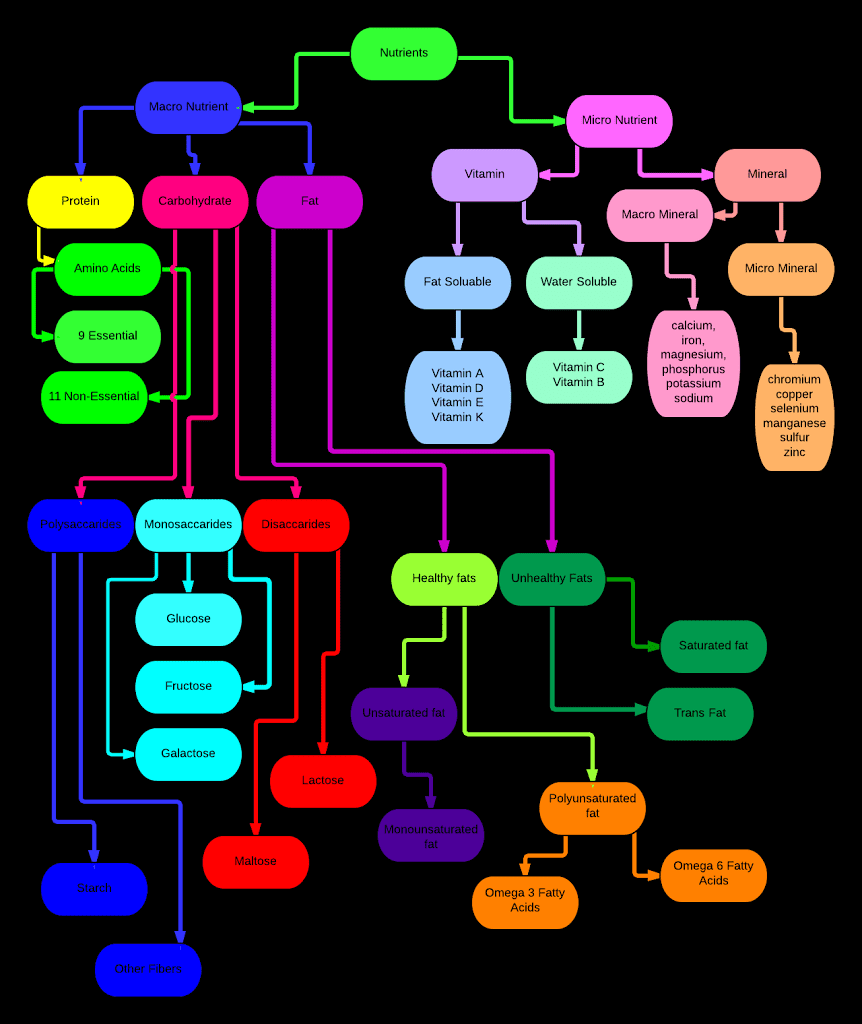A really, really, really fast overview of Human Nutrition:
There are two categories that encompass all food, and then there are many sub categories for each food. Below is a flow chart that will help show you where each of the “buzz words” you have often hear belong. This by all means is not a comprehensive list, but a list of the major or most common parts of our food.

Vitamins & Minerals
Vitamins and Mineral are necessary for normal body functioning and cellular processes. Necessary vitamins and minerals can be obtained by eating a mix of fruits, vegetables, meat, and other fortified foods as well as taking supplements. Some vitamins our bodies can synthesize, but others need to come entirely from our diet.
Carbohydrates
This macronutrient can be found in fruits, veggies, grains, beans, and basically any plant based food as well as dairy. Contrary to what many people believe, carbs are not just your pastas and breads, but are a lot more and vitally necessary to normal body functioning. Some people believe that there are good carbohydrates as well as bad carbohydrates. Added sugars, refined sugars and refined grain products are considered “bad” carbohydrates, because since they are reduced to their simplest form the body can very easy digest it quickly without giving you the feeling of fullness or the added benefits of fiber, vitamins and minerals. Good carbohydrates are often more complex (it takes the body several steps to digest them) and are naturally occurring, like fruit, vegetables and beans. Carbohydrates provide the quickest source of fuel for the body.Carbohydrates provide 4 calories for every gram consumed.
Protein
Protein can be found in meat, eggs, beans, nuts and seeds. The protein content varies for each source, but the latter are all considered sources of protein in our diet. Protein is made up of Amino Acids which are essential for our bodies and the cells that make up our bodies to function normally.
There are 9 essential Amino Acids and 11 non-essential Amino Acids. A non-essential Amino Acid means that our bodies can create that specific Amino Acid by combining other things we eat to make it. An essential Amino Acid means that the only place our bodies can get those Amino Acids is from the food we eat. Animal protein gives us all 9 essential Amino Acids, making it a complete or perfect protein. Plant proteins often need to be combined with two different types to get a perfect protein. Protein does a better job of keeping us full for longer because it takes longer for our systems to digest it.
Protein is the only macro-nutrient that can be over consumed. The highest amount of protein that can be safely consumed for an active individual is 2.0 grams per kilogram of body weight per day. Most people do not get to this point however.
Protein provides 4 calories for every gram consumed.
Fat
Fat can be found in a variety of food sources. There is are typically two different categories of fat, unhealthy and healthy, although there are many very different views on fat and what is healthy and unhealthy. Our bodies use fat to make cell walls, protect and insulate the body and store vitamins and minerals as well as many other things. Your body needs nutritional fat to function, but also makes it’s own fat if you consume more calories than you burn.
Unsaturated fat comes mostly from plant sources and saturated fat comes mostly from animal sources. You can easily tell the difference between the two because unsaturated fat is a liquid at room temperature and saturated fat is solid at room temperature. There are also two different types of unsaturated fat; polyunsaturated and monounsaturated fat. In the polyunsaturated fat category, there are two types, omega 3 and omega 6 fatty acids. It is important to have an even ratio between the two.
Fat takes longer to digest in the body and since small portions have higher amounts of calories than the other macronutrients, fat consumption should be monitored.
Fat provides 9 calories for every gram consumed.
To learn more and for more in depth explanations or practical advice, visit these reputable sites:
Mayo Clinic Healthy Living
Choose My Plate
Nutrition.gov
Disclaimer:
The site does not provide medical or legal advice. This Web site is for information purposes only.
The medical and/or nutritional information on this site is not intended to be a substitute for professional medical advice, diagnosis, or treatment. Always seek the advice of your physician or other qualified health provider with any questions you may have regarding a medical condition. Never disregard professional medical advice or delay seeking it because of something you have read on this Web site.
